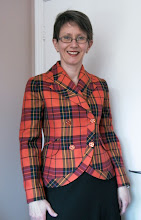The dragon design was lifted from a strange little stuffed object, which you can see at right. I have no idea what its origins might be. I think it was mainly red on the other side.
I traced the shape from the original and cut it from some sturdy green fabric. I must have interfaced before applying the eye and machine stitched decorative zig-zag pattern since there is no puckering at all. The teeth and nails were little folded pieces of white fabric, and the tufts were made from some white yarn. The eye is a black button.
I balanced the back's fanciness by making up a star and moon for the front pockets.
The coat itself is super simple. For the shell, I used an outerwear fabric called Commander (according to the MacPhee Workshop site, it's a 75-25 poly-cotton blend). To line, I used a 200 weight polar fleece. With a pair of bib-front overall snow pants (from a Kwik-Sew pattern, also much-used) in the same fabric, the suit kept my two-year-old warm and dry all winter.
The following winter, my toddler had turned into a little boy who was pretty interested in fire trucks. He told me he wanted a snow suit that looked like the uniforms then in use by Ottawa firefighters. I found the guys on the trucks quite willing (after they had verified the call to our street was a false alarm) to talk about the features of their suits so was able to take notes and sketch the details, including the distinctive pattern for the retro-reflective tape. It's different for the front and back which is useful in a dark and smoky environment. The hardest part was locating yellow retro-reflective tape but somehow I did it.
The year after that, dinosaurs were the all-consuming passion. You've already seen his Hallowe'en costume. Well, his winter jacket had dinos on it too, but they were pretty subtle... (click to enlarge).
This coat also incorporated retro-reflective features - piping at the collar, shoulder and forearm. I probably put some in the back too. It's a really great safety feature during our long dark winters.
If you have a little one, experiment and enjoy!














